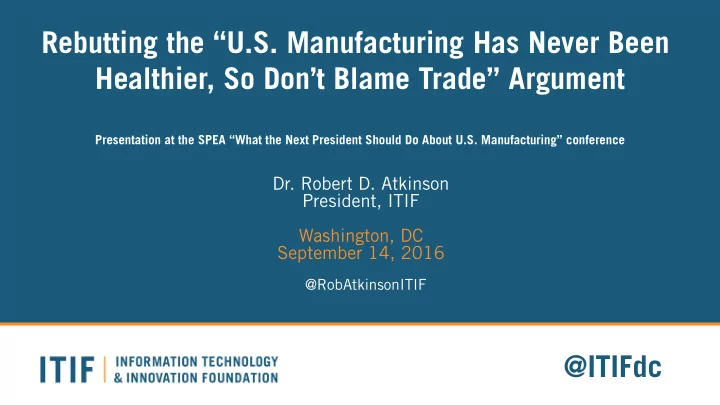

Rebutting the “U.S. Manufacturing Has Never Been Healthier, So Don’t Blame Trade” Argument Presentation at the SPEA “What the Next President Should Do About U.S. Manufacturing” conference Dr. Robert D. Atkinson President, ITIF Washington, DC September 14, 2016 @RobAtkinsonITIF @ITIFdc
About ITIF One of the world’s top science and tech think tanks Formulates and promotes policy solutions that accelerate innovation and boost productivity to spur growth, opportunity, and progress Focuses on a host of issues at the intersection of technology innovation and public policy: – Innovation processes, policy, and metrics – Science policy related to economic growth – E-commerce, e-government, e-voting, e-health – IT and economic productivity – Innovation and trade policy 2
The Problem We need a robust national manufacturing competitiveness strategy. However, that requires a consensus that there is a competitiveness challenge for U.S. manufacturing. Unfortunately, the Washington trade establishment engages in willful disregard of the data and evidence of the competitive challenges facing U.S. manufacturing. They go out of their way to assert that U.S. manufacturing has never been healthier and the all or the vast majority of job loss is from superior productivity, not competitiveness challenges. The trade establishment worries that if the evidence shows that there is a competitiveness challenge for manufacturing, that support for globalization and increased trade will fall. The problem is that their “denialism” means that the support for needed solutions (e.g., more trade enforcement, a stronger domestic manufacturing strategy) is weakened. Why act when all is well? 3
Washington Trade Establishment: “All is Well” Their Claims: Manufacturing output and exports at all-time levels U.S. global share unchanged Manufacturing job loss due to technology, not trade 4
CLAIM: Manufacturing Exports At All-Time High REALITY: Manufacturing Imports and Exports, 2002-2015 Exports Imports GDP at all time high, Billions of Current U.S. Dollars $2,100 imports even higher $1,900 $1,700 Exports have grown, but $1,500 imports have grown faster $1,300 Manufacturing trade $1,100 deficit up 35% since $900 2012 $700 $500 5
CLAIM: Manufacturing Output At All-Time High “U.S. factories produce Real Value-Added Growth, 2000 = 100 twice as much stuff as they 135 130 did in 1984.” 125 —Rex Nutting, MarketWatch, 3/28/2016 120 Axis Title 115 REALITY: 110 105 GDP grew even faster (up 100 230 percent) 95 90 Manufacturing output down 1% since 2007, while GDP is up 10% Manufacturing Rest of economy 6
CLAIM: U.S. Share Unchanged “The U.S. share of global U.S. Share of Global Manufacturing Output manufacturing has held at 27% around 20 percent for 40 25% years.” 23% —Robert Zoellick, WSJ, 8/7/2016 21% REALITY: 19% In fact, it has declined by 17% 7 percentage points since 2000. 15% 7
CLAIM: Productivity Killed Jobs “Manufacturing employment Manufacturing Sector by Decade has fallen because of 80% 65.6% productivity growth, not a 60% 53.0% decline in output.” 40% —Congressional Research Service 24.5% 17.8% 20% REALITY: 0% Then why did we lose 2.4% -2.4% -20% of manufacturing jobs in the 90s when manufacturing -40% -33.2% productivity growth was 1990-2000 2000-2010 similar? Employment Productivity Productivity Delta 8
REALITY: Most Industries Are Producing Less Value-Added Growth by Industry, 2008-2015 -30%-20%-10% 0% 10% 20% 30% 40% 50% Real manufacturing value Manufacturing added grew 2% from Primary metals 2008 to 2015 Computer and electronic products Rest of the economy grew Miscellaneous manufacturing 11% Chemical products Food and beverage and tobacco products 14 of 19 manufacturing sectors lost output Machinery Nonmetallic mineral products Apparel and leather and allied products Textile mills and textile product mills Furniture and related products 9
REALITY: USG Overstates Output Growth Computers and Real Value Added Growth, 2000=100 electronics (NAICS 334) 130 accounted for 111% of 120 U.S. manufacturing value added growth from 2005 110 to 2015 100 90 Manufacturing Manufacturing minus computers Rest of economy 10
Relevant ITIF Reports “The Myth of America’s Manufacturing Renaissance: The Real State of U.S. Manufacturing” “A Critique of CRS’s ‘U.S. Manufacturing in International Perspective’” “Worse Than the Great Depression: What the Experts Are Missing About American Manufacturing Decline” 11
Thank You! Robert D. Atkinson | ratkinson@itif.org | @RobAtkinsonITIF @ITIFdc
Recommend
More recommend